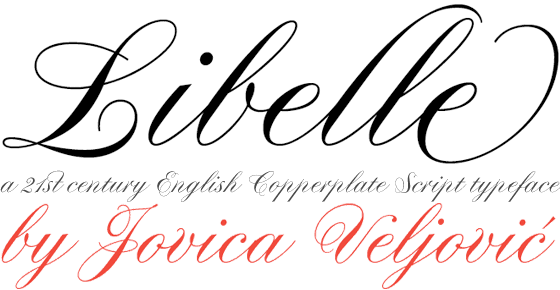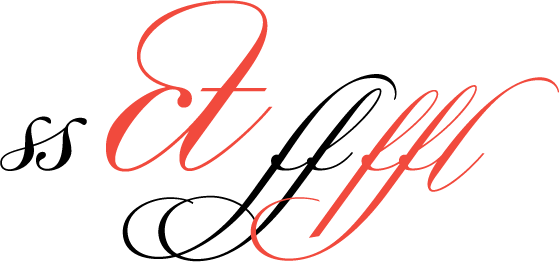Discover legacy content from linotype.com, preserved for your reference.
Libelle
Meet the newest typeface from master designer Jovica Veljović – Libelle

Libelle™ is a 21st century English Copperplate Script typeface. Created by Jovica Veljović, a designer with decades of experience as a calligrapher, typeface designer, and professor, Libelle differentiates itself from other Copperplates Scripts because its letterforms are less mechanical. The hand of the calligrapher shows through the forms, breathing new life into this historic genre. Libelle includes approximately 400 extra glyphs, including alternate forms of many letters and special forms for the beginnings and ends of words. The font includes several stylistic sets, as well as ligatures and ornaments.
Libelle’s OpenType Features
In order for the typeface to look its finest, Libelle should be used with the Contextual Alternates, Ligatures, and Discretionary features activated. Users will be able to find these features in their application’s OpenType menu. Only Adobe® CS products, as well as QuarkXPress®, will likely offer effective support for these OpenType features at the present time.
Contextual Alternates
Most users of Adobe InDesign® will find that the Contextual Aternates OpenType feature is active by default. When this feature is on, many letters will switch from their standard form to an alternate glyph, depending on what glyphs come immediately before or after them in a word.
Ligatures
The standard Ligatures feature is also active by default for many Adobe InDesign users. When this feature is on, the common ligatures that designers have come to expect in text will appear. For example, the fi combination will be replaced by and fi ligatures. The same substitution will occur with ff, fl, ffi, ffl, etc. Users of InDesign CS3 and higher may notice that language-specific exceptions are built in, for example the fi substitution is handled differently in Turkish, where the difference between an i with a dot and one without is important.
Discretionary Ligatures
The Discretionary Ligatures feature is not active by default in Adobe InDesign. Text set in Libelle will, however, look even more spectacular if users activate this feature when they are using the font. When the Discretionary Ligatures feature is on, additional ligatures will appear, including substitutions for ct, ll, ss, st, tt, tz, etc.
The standard Ligatures feature is also active by default for many Adobe InDesign users. When this feature is on, the common ligatures that designers have come to expect in text will appear. For example, the fi combination will be replaced by and fi ligatures. The same substitution will occur with ff, fl, ffi, ffl, etc. Users of InDesign CS3 and higher may notice that language-specific exceptions are built in, for example the fi substitution is handled differently in Turkish, where the difference between an i with a dot and one without is important.
Discretionary Ligatures
The Discretionary Ligatures feature is not active by default in Adobe InDesign. Text set in Libelle will, however, look even more spectacular if users activate this feature when they are using the font. When the Discretionary Ligatures feature is on, additional ligatures will appear, including substitutions for ct, ll, ss, st, tt, tz, etc.
 |
Initial Forms & Final Forms
Users of InDesign CS3 and higher will note that they make use of the Initial Forms and Final Forms feature. This feature should substitute the first and last letters of a line of text with special alternates, when these alternates are available. Libelle does not include alternate Initial and Final glyphs for all lowercase letters, since not all of them lend themselves to such treatment. But where appropriate, these additions are a treat for the eyes.
The implementation of the Final Forms feature in Adobe InDesign CS3 and CS4 is not as simple as designers and typesetters may expect. In order for a Final Form alternate to appear, the OpenType feature must first be activated, and then the character must be followed by a space (and no further characters on the line). Otherwise, InDesign is not aware that the character in question a Final one, and will not perform the substitution.
Users of InDesign CS3 and higher will note that they make use of the Initial Forms and Final Forms feature. This feature should substitute the first and last letters of a line of text with special alternates, when these alternates are available. Libelle does not include alternate Initial and Final glyphs for all lowercase letters, since not all of them lend themselves to such treatment. But where appropriate, these additions are a treat for the eyes.
The implementation of the Final Forms feature in Adobe InDesign CS3 and CS4 is not as simple as designers and typesetters may expect. In order for a Final Form alternate to appear, the OpenType feature must first be activated, and then the character must be followed by a space (and no further characters on the line). Otherwise, InDesign is not aware that the character in question a Final one, and will not perform the substitution.
Stylistic Sets
Libelle’s character set includes many alternate glyphs. The selection of alternates is larger than the number of substations called for in the above-mentioned OpenType features. In order to manually substitute an alternate glyph, users may take advantage of Adobe InDesign’s Glyph Pallette, or the Stylistic Sets menu. The lowercase a in Libelle alone has eight possible forms! Please note that QuarkXPress does not currently support Stylistic Sets.
Libelle’s character set includes many alternate glyphs. The selection of alternates is larger than the number of substations called for in the above-mentioned OpenType features. In order to manually substitute an alternate glyph, users may take advantage of Adobe InDesign’s Glyph Pallette, or the Stylistic Sets menu. The lowercase a in Libelle alone has eight possible forms! Please note that QuarkXPress does not currently support Stylistic Sets.
Stylistic Set 1
The design of Libelle’s alternate glyphs does not progress in a systematic manner. Every letter does not have the same number of alternates. While the lowercase a many have eight versions available, some letters do not have any alternates. This unsystematic nature is due to Libelle’s style. As an English copperplate-style script, not every letter is permitted to vary in the same manner. Alternates have only been created where appropriate.
When a letterform has a single alternate, it will appear in Stylistic Set 1. If a letterform has several alternates, its first alternate will appear in Stylistic Set 1. Libelle’s stylistic sets are built so the substitutions will be possible from any glyph variant to the called-for alternate form. So no matter whether you select the default form of the lowercase a, its Initial variant, its Final variant, etc., that selected lowercase a will be replaced by the version of the lowercase a found in Stylistic Set 1.
Stylistic Set 2
If a character has two or more alternate forms, the second alternate available is accessible in Stylistic Set 2.
Stylistic Set 3
If a character has three or more alternate forms, the third alternate available is accessible in Stylistic Set 3.
Stylistic Set 4
If a character has four or more alternate forms, the fourth alternate available is accessible in Stylistic Set 4.
Stylistic Set 5
If a character has five or more alternate forms, the fifth alternate available is accessible in Stylistic Set 5.
Stylistic Set 6
Stylistic Set 6 replaces all characters with an Initial Form variant, as long as an Initial version of that character is included in the Libelle Character Set. Libelle has Initial forms for the lowercase a, c, d, e, g, l, r, and all accented versions of these seven base characters (e.g., the á, or a with an acute accent).
The design of Libelle’s alternate glyphs does not progress in a systematic manner. Every letter does not have the same number of alternates. While the lowercase a many have eight versions available, some letters do not have any alternates. This unsystematic nature is due to Libelle’s style. As an English copperplate-style script, not every letter is permitted to vary in the same manner. Alternates have only been created where appropriate.
When a letterform has a single alternate, it will appear in Stylistic Set 1. If a letterform has several alternates, its first alternate will appear in Stylistic Set 1. Libelle’s stylistic sets are built so the substitutions will be possible from any glyph variant to the called-for alternate form. So no matter whether you select the default form of the lowercase a, its Initial variant, its Final variant, etc., that selected lowercase a will be replaced by the version of the lowercase a found in Stylistic Set 1.
Stylistic Set 2
If a character has two or more alternate forms, the second alternate available is accessible in Stylistic Set 2.
Stylistic Set 3
If a character has three or more alternate forms, the third alternate available is accessible in Stylistic Set 3.
Stylistic Set 4
If a character has four or more alternate forms, the fourth alternate available is accessible in Stylistic Set 4.
Stylistic Set 5
If a character has five or more alternate forms, the fifth alternate available is accessible in Stylistic Set 5.
Stylistic Set 6
Stylistic Set 6 replaces all characters with an Initial Form variant, as long as an Initial version of that character is included in the Libelle Character Set. Libelle has Initial forms for the lowercase a, c, d, e, g, l, r, and all accented versions of these seven base characters (e.g., the á, or a with an acute accent).
Stylistic Set 7
The lowercase l, and well as all of the l plus accent glyphs, have alternate Initial forms that may be accessed via Stylistic Set 7.
Stylistic Set 8
Stylistic Set 8 replaces all characters with an Final Form variant, as long as an Final version of that character is included in the Libelle Character Set. Libelle has Final forms for the lowercase a, c, e, g, l, n, o, r, s, t, u, y, and all accented versions of these base characters (e.g., the á, or a with an acute accent).
Stylistic Set 9
The lowercase a, e, n, y, as well as all of the accented versions of these base characters, have alternate Final forms that may be accessed via Stylistic Set 9.
Stylistic Set 10
The lowercase a and y, as well as all of the accented versions of these two base characters, have second alternate Final forms that may be accessed via Stylistic Set 10.
Slashed Zero
This Feature replaces the zero with a “slashed zero” alternate.
Fractions
Libelle includes nine pre-composed diagonal fractions. When the Fractions feature is active, these glyphs will be substituted for typed combinations like 1/2.
The lowercase l, and well as all of the l plus accent glyphs, have alternate Initial forms that may be accessed via Stylistic Set 7.
Stylistic Set 8
Stylistic Set 8 replaces all characters with an Final Form variant, as long as an Final version of that character is included in the Libelle Character Set. Libelle has Final forms for the lowercase a, c, e, g, l, n, o, r, s, t, u, y, and all accented versions of these base characters (e.g., the á, or a with an acute accent).
Stylistic Set 9
The lowercase a, e, n, y, as well as all of the accented versions of these base characters, have alternate Final forms that may be accessed via Stylistic Set 9.
Stylistic Set 10
The lowercase a and y, as well as all of the accented versions of these two base characters, have second alternate Final forms that may be accessed via Stylistic Set 10.
Slashed Zero
This Feature replaces the zero with a “slashed zero” alternate.
Fractions
Libelle includes nine pre-composed diagonal fractions. When the Fractions feature is active, these glyphs will be substituted for typed combinations like 1/2.
more ...